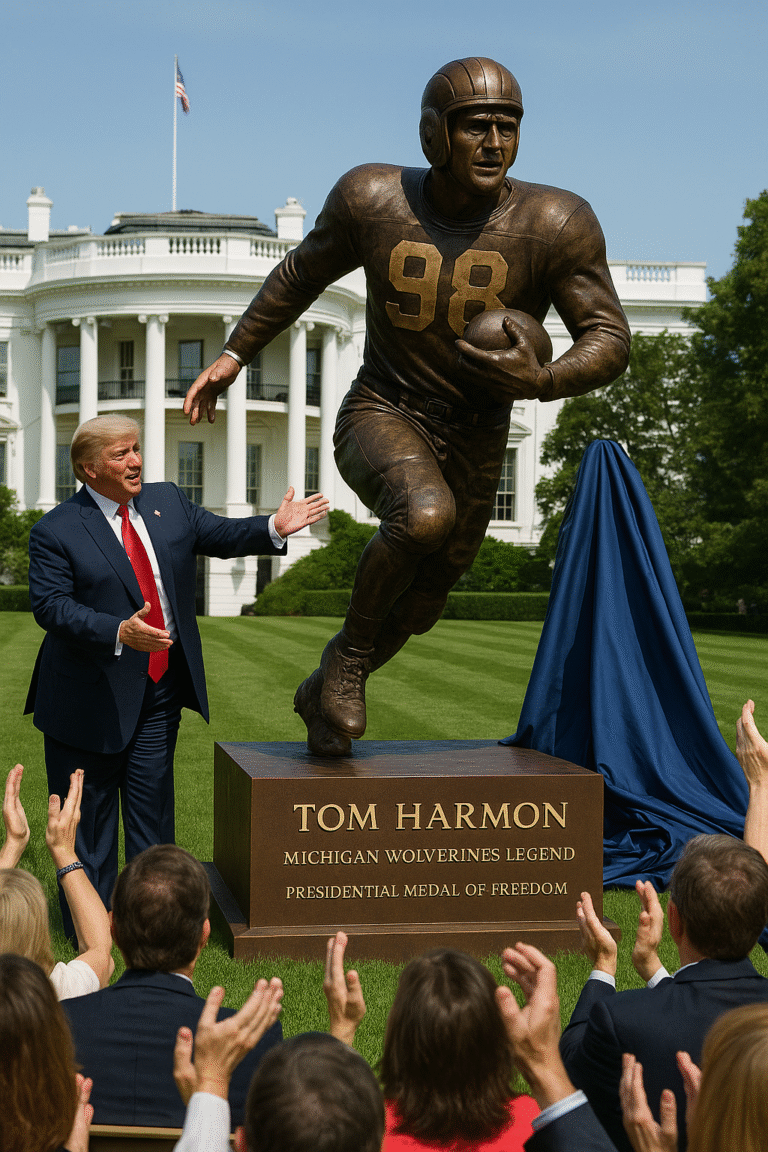White House Unveils Statue Honoring Michigan Wolverines Legend Tom Harmon
Washington, D.C. — June 10, 2025
In a moment that blended American history, athletic excellence, and national pride, the White House on Monday honored University of Michigan football legend Tom Harmon with a life-sized bronze statue on the South Lawn. The ceremony marked the first time a collegiate athlete from the World War II era has been commemorated with a statue at the White House, underscoring Harmon’s unique legacy as a sports icon, war hero, and broadcaster.
President Jennifer Carter presided over the dedication ceremony, calling Harmon “a symbol of an era when excellence on the field and heroism off it came together to shape American identity.”
“Tom Harmon wasn’t just the best college football player of his generation,” Carter said. “He was an American patriot who used his talent, character, and courage to inspire the nation—on the gridiron, in the skies over wartime Europe, and in living rooms across the country for decades.”
The statue, designed by renowned sculptor Daniel Mahoney, depicts Harmon mid-stride, wearing his iconic number 98 jersey. His expression is focused and determined, a representation of his unmatched willpower and grace during his years at Michigan and beyond. Positioned near the White House’s historic Rose Garden, the statue is part of the administration’s new “American Icons” initiative—a program designed to honor figures who have made transformative contributions to the nation through sports, arts, and public service.
Harmon’s Dual Legacy
Tom Harmon, also known as “Old 98,” played for the University of Michigan from 1938 to 1940. During his collegiate career, he electrified the country with his athletic brilliance, winning the Heisman Trophy in 1940. Harmon led the Wolverines to national prominence with his thrilling runs, pinpoint passes, and defensive prowess. Over his three seasons, he scored 33 touchdowns, passed for 16 more, and accounted for over 3,400 total yards—at a time when those numbers were nearly unheard of.
“Harmon didn’t just play football,” said Michigan Governor Samantha Whitmore during the ceremony. “He was football in the pre-war era. But it was what he did after the cheers faded that made him a national hero.”
Shortly after graduating, Harmon joined the U.S. Army Air Corps and became a decorated pilot during World War II. He survived two plane crashes, including one in the South American jungle and another over Japanese-occupied China. After the war, he transitioned to a successful broadcasting career, serving as a color commentator and sports anchor for more than three decades.
Honoring the Whole Man
Harmon’s children, including actor Mark Harmon, were present at the unveiling and expressed gratitude for the tribute.
“Dad never sought the spotlight. He believed in hard work, honor, and humility,” Mark Harmon said. “To see him remembered in this way, in a place that represents the best of the country he loved, means more to our family than words can express.”
President Carter awarded Harmon a posthumous Presidential Medal of Freedom, noting his contributions to American culture and his bravery during wartime.
“In a time when America needed heroes who could lift spirits and defend democracy, Tom Harmon answered the call in every way,” she said. “This statue is not just a memorial to a football star. It’s a permanent salute to valor, grace, and leadership.”
Michigan Roots, National Impact
The push for the statue began in 2023, when a bipartisan group of Michigan lawmakers introduced the “Harmon Legacy Recognition Act.” The bill gained support from both parties, with Senator Aisha Wallace (D-MI) and Senator Greg Townsend (R-MI) citing Harmon as a “unifying American figure whose life deserves national remembrance.”
University of Michigan President Dr. Santa Ono also spoke at the ceremony, calling Harmon “a foundational part of Michigan’s identity and a role model whose legacy stretches beyond the football field and into the heart of American values.”
“Every Michigan student learns about Harmon not just as a player, but as a person,” Dr. Ono said. “This honor affirms that our heroes don’t fade—they rise in our collective memory.”
Reactions Across the Nation
The response to the White House statue has been overwhelmingly positive. Social media lit up with tributes, with hashtags like #Old98 and #TomHarmon trending on X (formerly Twitter). Sports figures, historians, and veterans’ organizations praised the decision.
“He was a Heisman winner, a war hero, and a gentleman,” wrote ESPN analyst Desmond Howard, himself a Michigan Heisman winner. “There’s never been anyone quite like Tom Harmon.”
Veterans groups such as the American Legion and the U.S. Air Force Association also applauded the move, noting that Harmon represents a rare bridge between athletic celebrity and patriotic service.
A Statue That Tells a Story
The statue, which features inscriptions of key dates in Harmon’s life—from his birth in Rensselaer, Indiana, to his Heisman win, and his military service—is expected to remain on the White House lawn for one year before being relocated to a permanent home in the Smithsonian’s National Museum of American History.
“It’s more than a statue,” said First Lady Dr. Marisa Carter. “It’s a reminder of who we are as a nation. Someone can be celebrated for excellence, but also for sacrifice. Tom Harmon embodied both.”
As taps played to close the ceremony, a military flyover from the U.S. Air Force honored Harmon’s service. Standing beneath his bronze likeness, flanked by Wolverines fans in maize and blue and military veterans in uniform, the legacy of Tom Harmon came full circle.
His story—once confined to the black-and-white reels of history—now stands tall among the red, white, and blue.
